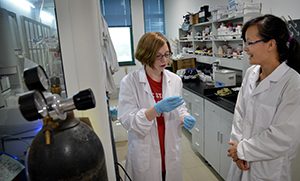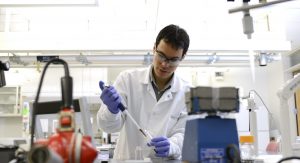Laboratory environments present diverse research and teaching safety and health needs.
This resource guide is to help laboratorians with various safety services we offer.


Principal Investigators
Specific information is available for Principal Investigators that supplements the information available for laboratory students and staff.
Safety Plans and Research Protocols
All “laboratory” locations that use hazardous materials and hazardous processes need to have a Safety Plan. Environmental Health uses safety plans to assure we receive accurate and timely inventory data for mandatory environmental reporting and ascertain better information about potential laboratory hazards. Safety plans are created and submitted electronically and require at least an annual update. One hard copy should be located in the laboratory facility at all times.
In addition to an approved safety plan, select hazardous materials require specific authorizations and approvals before starting work. Often these regulated areas for significant inspection activity, are actively scrutinized by the overseeing agencies, or may have particularly heavy fines associated with non-compliant findings (sometimes for seemingly insignificant infractions) or otherwise severe impacts to research.
- Biological Safety – Biological Use Authorizations, Select Agents
- Radiation Safety – Principal Investigator Authorizations for materials and
x-ray generating devices
Lab Safety Resources – Explore the detailed information and resources available to maintain proper laboratory safety
- Safety Related Items Needing Review or Approval
- Laboratory Safety resources includes information on hazard review processes, personal protection equipment, chemical safety and more.
- Lab Startup and Relocation (LOOP) forms can be used to open a new lab, close or move your existing laboratory space on campus.
Supervisor and Lab Manager Resources
- Supervisors and PI’s should review NC State Health and Safety programs and services which apply to his/her operation.
- Supervisors should use the NC State Safety Orientation Checklist and the Training Needs Assessment Matrix as the means for training new employees.
- Additional guidance information is provided in the Supervisor Responsibilities’ Quick Facts!
Waste Management Practices
For generators of Unwanted Material, proper management is needed. Submission for waste pickup follows a set schedule, once a request is submitted via EHSA.
Animal Contact
Work with animals? Review animal contact information, animal contact monitoring programs and minimize risks from animal contact.
EHS Inspections
Environmental Health and Safety conducts inspections, in accordance with various regulatory and compliance obligations. Inspections include chemical/laboratory, hazardous waste, fire/life safety, equipment, biological and radiological reviews, each with varying frequency. These inspections help identify safety and health concerns, demonstrate compliance with regulatory requirements and promotion of safe work practices. Ultimate responsibility for complying with the reasonable health and safety requirements rests with each principal investigator.
Shipping Hazardous Materials
Proper shipping and receiving of hazardous materials requires IATA training certification, transportation security, packaging and shipping procedures.
Environmental Health and Safety Assessment Questions
Does your laboratory have proper access and security precautions?
- Emergency procedure/security guidance
- Visitor Access to Laboratories & Workshops
- Minors as Volunteers in Field, Laboratory
- Working Alone
Safety Resources – Your work may involve other potentially hazardous activities.